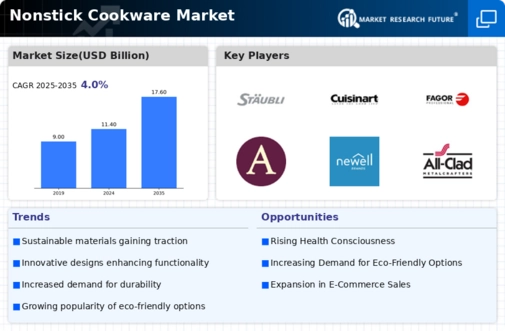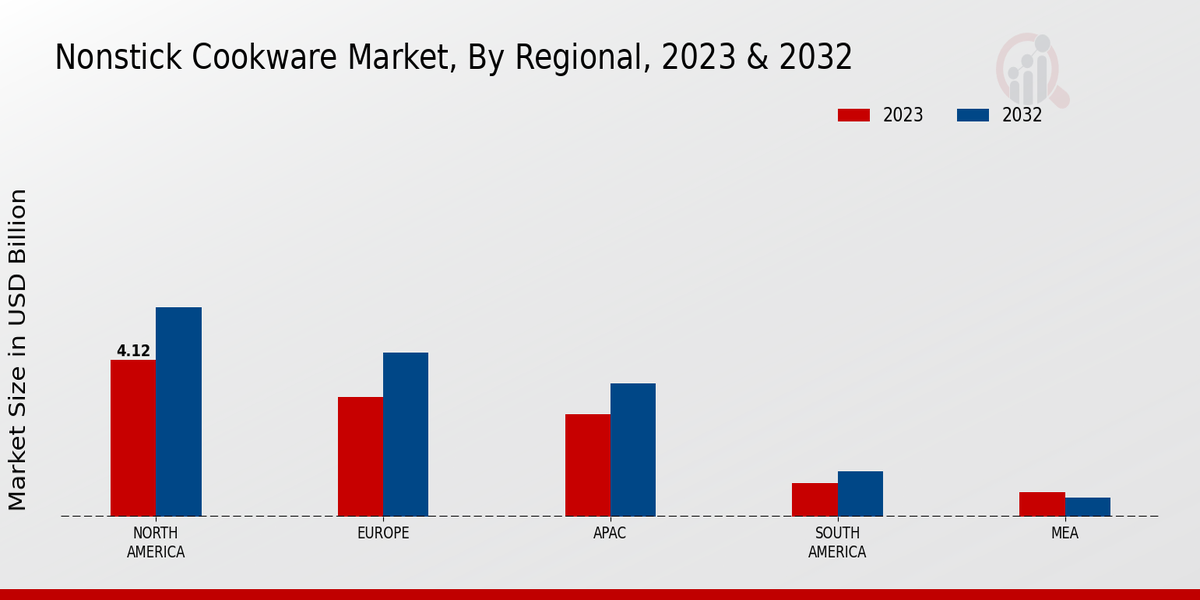Market Growth Projections
The Global Nonstick Cookware Market Industry is poised for substantial growth in the coming years. Projections indicate that the market will reach 11.4 USD Billion in 2024 and is expected to expand to 17.6 USD Billion by 2035. This growth trajectory suggests a compound annual growth rate of 4.01% from 2025 to 2035. Such figures highlight the increasing consumer interest in nonstick cookware, driven by factors such as health consciousness, technological advancements, and the rise of e-commerce. The market's expansion reflects broader trends in consumer behavior and preferences, indicating a robust future for nonstick cookware.
Expansion of E-commerce Platforms
The rise of e-commerce platforms significantly influences the Global Nonstick Cookware Market Industry. Online shopping provides consumers with convenient access to a wide range of nonstick cookware options, often at competitive prices. This trend is particularly relevant in the current digital age, where consumers increasingly prefer the convenience of online shopping over traditional retail. E-commerce platforms also enable brands to reach a broader audience, including international markets. As a result, the market is likely to witness sustained growth, with projections indicating a compound annual growth rate of 4.01% from 2025 to 2035, driven by the accessibility and convenience of online purchasing.
Growing Popularity of Cookware Brands
The Global Nonstick Cookware Market Industry benefits from the increasing popularity of established cookware brands. Renowned brands invest significantly in marketing and product development, which enhances consumer trust and loyalty. This trend is particularly pronounced in regions with a strong culinary culture, where consumers are willing to invest in high-quality cookware. The presence of well-known brands not only drives sales but also encourages competition, leading to improved product offerings. As the market evolves, brand recognition becomes a crucial factor in consumer purchasing decisions, contributing to the overall growth of the industry.
Technological Advancements in Cookware
Technological innovations play a pivotal role in shaping the Global Nonstick Cookware Market Industry. Manufacturers are continually developing advanced nonstick coatings that enhance durability and performance. For instance, the introduction of ceramic-based nonstick surfaces offers consumers a safer alternative to traditional coatings, appealing to environmentally conscious buyers. These advancements not only improve the cooking experience but also extend the lifespan of cookware. As a result, the market is expected to grow steadily, with a projected value of 17.6 USD Billion by 2035. This growth is indicative of the industry's ability to adapt to consumer preferences and technological trends.
Increasing Focus on Sustainable Products
The Global Nonstick Cookware Market Industry is witnessing a shift towards sustainable and eco-friendly products. As environmental concerns become more prominent, consumers are increasingly seeking cookware that minimizes environmental impact. This trend is reflected in the growing demand for nonstick cookware made from sustainable materials and free from harmful chemicals. Manufacturers are responding by developing products that align with these values, thereby attracting environmentally conscious consumers. This focus on sustainability not only enhances brand reputation but also contributes to market growth, as consumers are willing to pay a premium for products that reflect their values.
Rising Consumer Demand for Healthy Cooking
The Global Nonstick Cookware Market Industry experiences a notable increase in consumer demand for healthier cooking options. As more individuals prioritize health and wellness, nonstick cookware, which requires less oil and fat, becomes increasingly appealing. This trend is particularly evident in urban areas where busy lifestyles necessitate quick and healthy meal preparation. In 2024, the market is projected to reach 11.4 USD Billion, reflecting a growing awareness of nutrition and cooking methods. Consumers are actively seeking products that facilitate healthier eating habits, thereby driving the demand for nonstick cookware that aligns with these preferences.
















